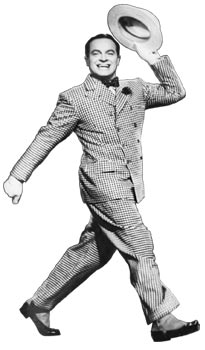

|
Vaudeville was Bob Hope's training ground, where he honed the abilities as an actor, comic monologist, dancer, singer, sketch comedian, and master of ceremonies that made him one of the most popular entertainers of the twentieth century. In the 1920s Hope toured the United States as a vaudevillian, performing in hundreds of theaters, small and large. His talents and ambitions made him one of the great stars of the variety stage. From the early 1880s to the end of the 1920s, vaudeville was the most popular form of live entertainment in the United States. A vaudeville show was a succession of seven to ten live stage acts, which included comedians and musicians, together with novelty acts such as dancers, acrobats, trained animals, and magicians. Its form and content were shaped by a wide range of nineteenth-century diversions, including minstrel shows, the circus, medicine shows, traveling repertoire companies, curio museums, wild West shows, chautauquas, and British music hall. If vaudeville had an American creator, it was Tony Pastor. Pastor brought variety act entertainment out of men's saloons and "refined" it into family entertainment when, in 1881, he opened his 14th Street Theater in New York City. Vaudeville's audiences, as well as many of its stars, were drawn primarily from the newly immigrated working classes. |
 |
|
|
The growth of vaudeville coincided with, and also reflected, the rise of urbanization and industrialization in America. As vaudeville grew more popular, centralized business interests took control of the acts. Just as goods in the late nineteenth century could be manufactured in a central location and shipped throughout the country, vaudeville routines and tours were established in New York and other large cities, and tours were made possible by the new ease of long-distance transportation afforded by the railroad. A successful act would be booked on a tour lasting for months and would change little as it was performed through the United States. In this way, vaudeville became a means of creating and sharing national culture. Bob Hope was among the 20,000 vaudeville performers working in the 1920s. Many of these performers were, like Hope, recent immigrants to America who saw a vaudeville career as one of the few ways to succeed as a "foreigner" in America. Throughout his extraordinary professional career of nearly seventy years, Bob Hope practiced the arts he learned in vaudeville and perpetuated variety entertainment traditions in stage musical comedy, motion pictures, radio, television, and the live appearances he made around the world in support of American armed forces. Today, the stage variety show is mostly a memory but its influence is pervasive thanks to the long and rich careers of vaudeville veterans like Bob Hope.
|
||
Contact Us ( July 1, 2005 )